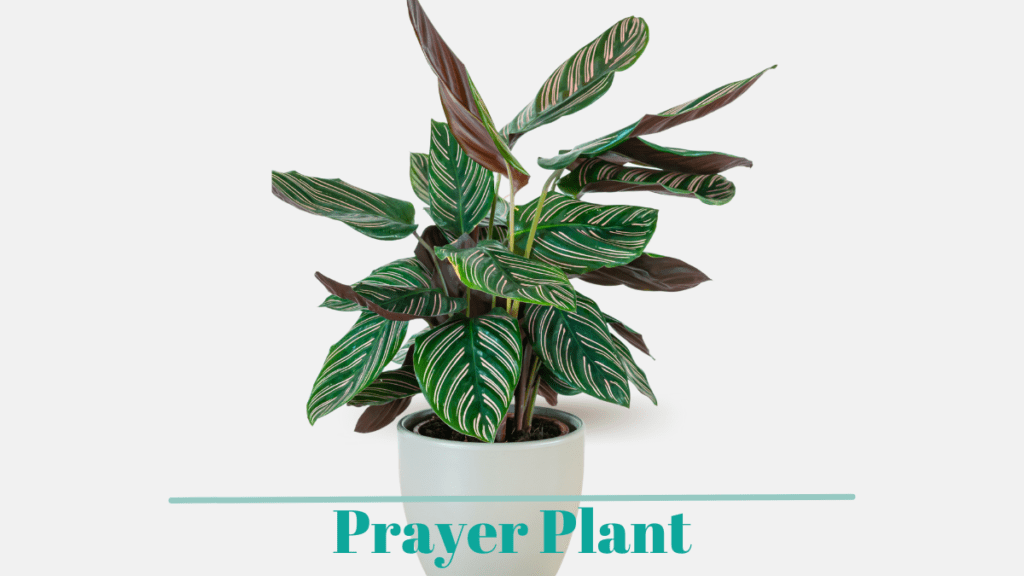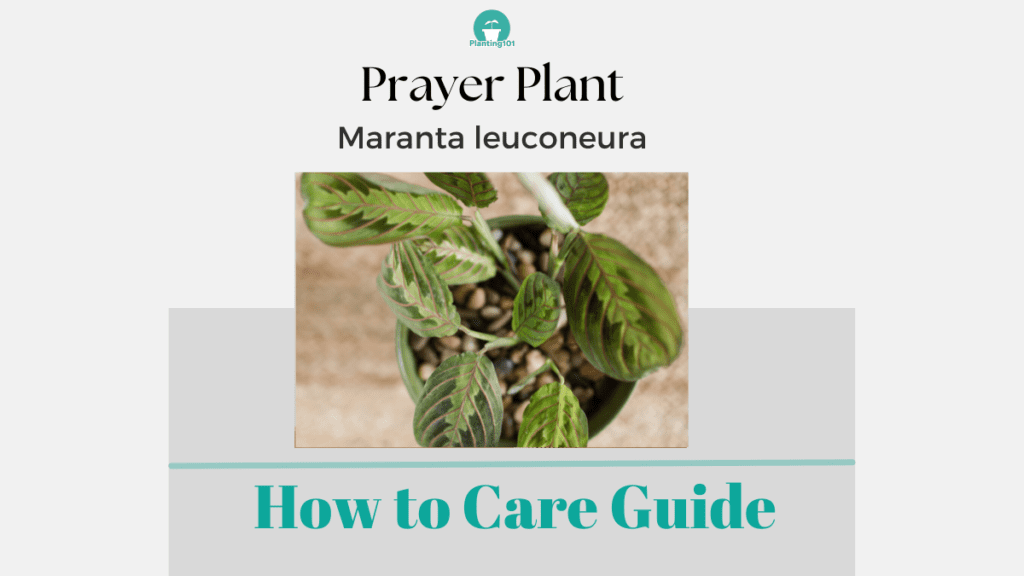Prayer Plant (Maranta leuconeura) is not the easiest houseplant to care for but nevertheless, it is a very popular houseplant. It is popular because of its beautiful herringbone-patterned leaves and is beloved for its daily ceremony. The leaves of the Prayer Plant curl up when it gets dark and when you turn on the light, the leaves will unroll to their regular flat position. It’s a lot of fun to trick your prayer plant into rolling and unrolling its leaves by turning on and off the light. Here are tips on how to take care of your Prayer plant indoors.
Read about how my teenage daughter killed her prayer plant! Prayer Plants are hard to care for!

Prayer Plant Infographic

Prayer Plant Basics
| Name | Prayer Plant |
| Scientific Name | Maranta leuconeura |
| Care Level | Moderate |
| Light | Filtered Light. Can Tolerate Low Light. |
| Daytime Temperature | 70 to 80 F (21-26C) |
| Night Time Temperature | 60 to 70 F (15-21C) |
| Water | Moderate Water |
| Humidity | High Humidity |
| Potting | Well-draining, organic, all-purpose potting mix |
| Fertilizer | Once every 2 weeks at half strength (Growing Season). Once a month in the winter. |
Prayer Plant: Other Names
Prayer Plant is also called Maranta, Herringbone Plant, and Rabbit’s Foot.
Prayer Plant: Varieties
Maranta leuconeura ‘Kerchoviana’
Maranta leuconeura ‘Erythroneura’
Prayer Plant: Size
A prayer plant can grow to 12 inches tall and 16 inches wide.
Light
Prayer Plant: Sun or Shade?
Prayer Plant is will grow best in filtered light locations but it can also tolerate low light locations. It will do well in a north-facing window. It will also thrive in indoor spaces with artificial light. Although, your Prayer Plant will do best in an east-facing window with filtered sunlight.
Water
How Often Should You Water Your Prayer Plant?
Water your Prayer Plant when the soil feels dry. The best way to tell when it is time to water your Prayer Plant is to feel the soil. Stick your finger in the soil 1 inch deep. If the soil feels dry, it’s time to water your Prayer Plant.
What Type of Water Should You Use When Watering Your Prayer Plant?
Your Prayer Plant can be watered with tap water but be mindful of the water temperature that you are using to water your Prayer Plant. Don’t use straight cold water from the tap to water your Prayer Plant. Prayer Plant prefers cool water that is not hot and not cold.
When you turn on the cold water from the faucet add a little bit of warm water. You can also get to this ideal temperature by filling a watering can or pitcher with water and leaving it out overnight until the water is at room temperature.
How Do You Make Sure There is Proper Drainage for Your Prayer Plant?
Make sure your Prayer Plant is in a pot with drainage holes. After watering your Prayer Plant and you see water draining out of the pot’s drainage holes, make sure you empty out the accumulated water in the saucer. Don’t let your Prayer Plant’s pot sit in this puddle of water. It will cause root rot!
Do You Need to Mist Your Prayer Plant?
Your Prayer Plant is a tropical plant that thrives in humid conditions. Indoor air can be drying. Make sure you do your best to increase indoor humidity. You can do this by spraying your Prayer Plant with water twice a week. Turn on the humidifier. Keep Prayer Plant in a saucer filled with water. But make sure the pot is elevated with pot feet or pebbles so your Prayer Plant is not sitting directly on the water.
Soil
What Type of Potting Mix is Best for Your Prayer Plant?
Your Prayer Plant needs a well-draining, organic potting mix.
How Do You Know When To Repot Your Prayer Plant?
Repot your Prayer Plant every year in the Spring. Repot in a container with a diameter 2 inches larger than the current pot. Prayer Plant like air around its roots, don’t pack the soil too tight.
Fertilizer
Do You Need to Fertilize Your Prayer Plant?
Your Prayer Plant should be fertilized once every 2 weeks during the growing season. Fertilize once a month in the winter months. Fertilize at half strength.
What Fertilizer Should You Use on Your Prayer Plant?
Use liquid, organic fertilizer with a higher ratio of nitrogen on your Prayer Plant.
Propagation
How Do You Propagate Your Prayer Plant?
Your Prayer Plant Prayer Plant Plant is easy to propagate. You can easily propagate your Prayer Plant plant by division. Below are steps on how to propagate Prayer Plant Plant by division.
1. Take a Stem Cutting of Prayer Plant Plant (include a node)
Pick a stem with a node. Cut below the node.
2. Place Prayer Plant Stem in Jar of Water
Place the Prayer Plant stem into a jar of water and wait for it to grow roots. To help it focus its energy on growing roots, make sure your stem has a maximum of 2 leaves. Cut off extra leaves as needed.
Another way to stimulate root growth is to dip your stem cutting in root hormone and plant it in moist sand. I personally prefer the jar method so you can easily see the roots come out. Know that not all stem cuttings of Prayer Plant will grow roots, so to be safe, cut a few stem cuttings so you will at least get one with roots.
3. Plant Stem Cutting in New Pot
Once the roots grow, plant these stem cuttings into a new pot. Water the new plant immediately after planting. Then water every 2-3 days until the roots are established.
4. Place New Prayer Plant Plant in a Spot with Bright Indirect Sun
Place your new Prayer Plant plant in a spot with bright indirect sunlight. Don’t put it in direct sunlight.
Common Problems of Prayer Plant Care
The most common problems that affect Prayer Plant are brown leaf tips and spider mites.
Prayer Plant: Yellow and Brown Spots with Spider-Like Webs on Leaves and Stems
Prayer Plant Problem: There are yellow and brown spots on the leaves of your Prayer Plant. You also see spider web-like webbing on the leaves and stems.

Cause: The spider webbing and yellow and brown spots are signs of spider mites attacking your Prayer Plant. Spider mites are tiny pests that are too small to see with your bare eyes.
Solution: To treat spider mites on your Prayer Plant, spray off the leaves with water from a garden hose. The force will cause the little spider mites to wash off the leaves. You can also wash mites off with soapy water or rubbing alcohol. There are also horticultural oils and insecticidal soaps that you can use to kill off spider mites.
Check out our article on how to make your own homemade pesticides using baby shampoo: How to Make Horticultural Oil and How to Make Insecticidal Soap
Prayer Plant: Tip of Leaves Turning Brown
Prayer Plant Problem: The tips of the leaves of your Prayer Plant plant are turning brown.
Cause: When the tips of the leaves of your Prayer Plant turn brown that is a result of not enough water or humidity. The tips of the leaves are turning brown because they are dying.
Solution: Water your Prayer Plant and increase humidity.
How to Increase Humidity for Your Prayer Plant
1. Water Your Prayer Plant Plant
Place your finger in the soil (1 inch deep) to check if it is dry. If the soil is dry, you should immediately water your Prayer Plant plant. Give it enough water to the point that you see water trickling out of the drainage hole. Make sure you empty the saucer and don’t let your Prayer Plant pot sit in a saucer filled with water. That will result in root rot.
2. It May Be Time to Repot Your Prayer Plant
It’s also possible the pot is too small for your Prayer Plant which is why it is not getting enough water. It may be time to repot your plant to a bigger pot.
3. Mist the Leaves of Prayer Plant Plant
If low humidity is the problem, you can mist the Prayer Plant plant leaves.
4. Turn on the Humidifier
The room may also be too dry for your Prayer Plant plant, turn on a humidifier so the room is not overly dry.
Once your Prayer Plant receives adequate humidity and water, the leaves will start to look healthy and green again. You do need to cut off the brown tips since they do not turn back to green.
Prayer Plant FAQ
Should I mist my prayer plant?
Yes, you should mist your prayer plant. Prayer plants need a humid environment, misting your prayer plant will increase humidity. If you can, lightly mist your prayer plant every 1-2 days. If that’s too much work for you, mist your prayer plant twice a week.
How Often Should I Water a Prayer Plant?
Prayer plants are humid-loving plants. You can’t let the soil dry up. You should probably water your prayer plant once every 3-4 days. The best way to tell if your prayer plant needs to be watered is to feel the soil. Stick your finger in the soil an inch deep, if the soil feels dry then it’s time to water your prayer plant. You will need to water your prayer plant more frequently in the winter when the indoor air is drier.
Can I put my Prayer Plant in the Bathroom?
Yes, it’s a good idea to put your prayer plant in the bathroom. Prayer plants are humid-loving tropical plants, the humid environment of a bathroom is ideal for prayer plants. However, make sure you give your prayer plant sufficient light. Only move your prayer plant to the bathroom if there is a window in your bathroom.
What Happens if You Overwater your Prayer Plant?
Overwatering your prayer plant can be fatal for your prayer plant. It will cause root rot and your prayer plant can from overwatering. Play it safe, feel the soil first before you water your prayer plant. Only water it when the soil feels dry.

